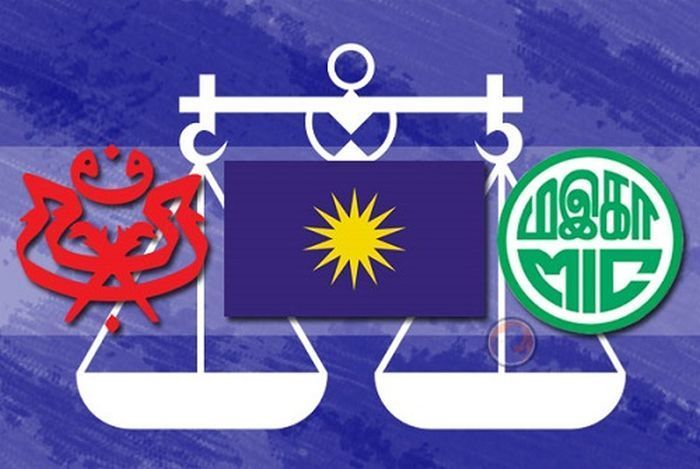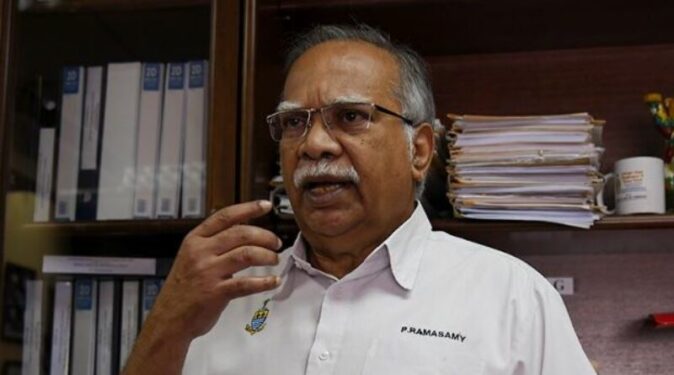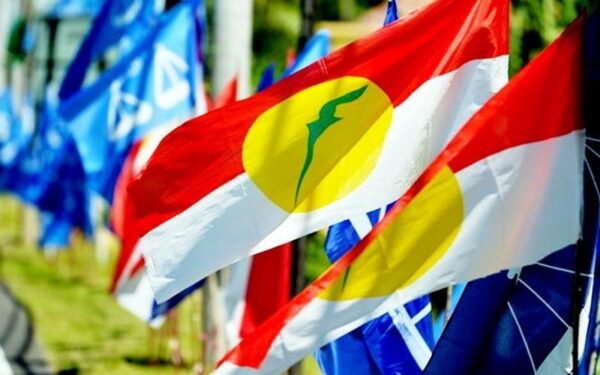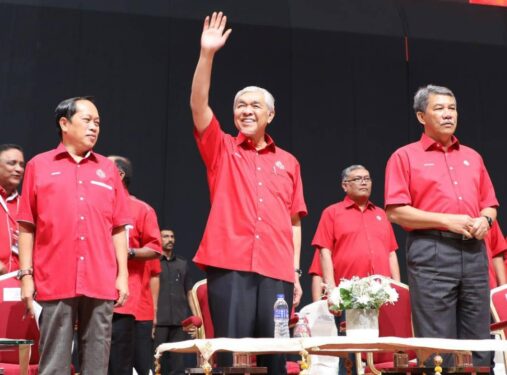
Is there a political future for parties such as MCA, MIC and Gerakan?
By Prof Ramasamy Palanisamy

ONCE MCA and MIC banded together with UMNO to constitute the triumvirate in the Alliance coalition.
It was this coalition that administered the country on the basis of an ethnic consociational model, political model of inter-ethnic bargaining and compromise.
It was Arend Lijphart, a political scientist, who suggested in the 1970s that this model was a way to bring about political stability in ethnically divided societies.
It was the coming together of these three principal ethnic political parties – even before the establishment of formal coalition – that convinced the British to give independence to the country in 1957.
Until the early 1970s, more so until the race riots of 1969, the three parties cobbled together to administer the country on the basis of a consociational arrangement.

Prof Ramasamy Palanisamy
The ethnic bargain was simple: in recognition or acceptance of Malay as the national language, the position of the royalty and certain special rights of Malays, the non-Malays were accorded generous citizenship rights including the use of their mother tongue in vernacular schools.
However, as the years passed on, the inter-elite political accommodation was unable to contain the increasing demands of the various races.
The clamour for the Malay share of national equity, the non-Malay demand for rights and others contributed in undermining the consociational model.
The system finally collapsed under the weight of the 1969 racial riots that called into question the very basis of the inter-ethnic bargaining model.
Following the riots, the Alliance coalition was discarded as something not politically viable to the rising demands of the various races particularly the Malays. In place of the Alliance, a larger political coalition called Barisan Nasional of National Front came into being.
While the Alliance had three political parties, BN came to contain 14 political parties – some from the regions of Sabah and Sarawak.
The BN coalition brought about change in the power relationship between the various component parties.
Under the Alliance, the relationship between UMNO, MCA and MIC was somewhat equal. Essentially, it was a political system based on ethnic bargaining and compromise.
UMNO’s the boss
However, under the BN, UMNO became the preponderant power whereas MCA, MIC and later Gerakan were reduced to mere component parties. The status and power that the three non-Malay parties had in Alliance was greatly diminished under BN.

In other words, the non-Malay parties in the BN became subservient to UMNO for survival to give the impression of non-Malay representation in the government.
Political scientist Ian Lustick calls this ethnic model as the controlled model of the government where one preponderant ethnic party sets the rules of political engagement.
Five decades of the non-Malay political presence in BN saw the gradual erosion of the power of the non-Malays.
While UMNO became increasingly assertive of Malay ethnic and religious rights, MCA, MIC and Gerakan could hardly offer any meaningful resistance to change the political course of the non-Malays.
It was just a matter of time before these three principal parties became unresponsive to the demands of non-Malays.
Given this, the non-Malays particularly the Chinese and Indians began deserting these parties to support the DAP and later PKR.
In the 2008 general election (GE), non-Malays dramatically shifted their loyalty to DAP and PKR in the PR coalition. The GE in 2008 was a watershed in the shifting of loyalties of non-Malays in support of the opposition.
From this period and onwards, it was downhill for MCA, MIC and Gerakan. In the subsequent GE in 2013, 2018 and 2022, the three parties lost badly with their winnings reduced to one or two seats especially with the Malay support from UMNO.
In 2018 and 2022, BN was not able to stage a political comeback. During the recently concluded 15th General Election (GE15), UMNO could only win 26 parliamentary seats whereas the other component parties in BN won four parliamentary seats.
Entire BN is weak
Internal problems within UMNO consequently affected the performance of the party to the extent that BN became one of the weakest political coalitions in the country.

I am not sure whether the three political parties MCA, MIC and Gerakan have a future. The very basis of their existence and relevance is no longer there.
Non-Malay ethnic parties have become irrelevant because of their subordinate position in the government.
The weakness of these parties is the larger weakness of BN. Malay extremism emanating from Perikatan Nasional (PN) might further erode the strength of these parties in BN.
UMNO is not sufficiently strong or vibrant to provide a lifeline for the survival of these parties.
In other words, the changed political, social and cultural circumstances have impacted negatively on these non-Malay political parties.
Under the present political circumstances, the vast majority of non-Malays have gravitated towards political parties such as DAP and PKR in PH.
Are these political parties relevant anymore? – Jan 19, 2023
Prof Ramasamy Palanisamy is the state assemblyperson for Perai. He is also Deputy Chief Minister II of Penang.
The ethnic bargain was simple: in recognition or acceptance of Malay as the national language, the position of the royalty and certain special rights of Malays, the non-Malays were accorded generous citizenship rights including the use of their mother tongue in vernacular schools.
However, as the years passed on, the inter-elite political accommodation was unable to contain the increasing demands of the various races.
The clamour for the Malay share of national equity, the non-Malay demand for rights and others contributed in undermining the consociational model.
The system finally collapsed under the weight of the 1969 racial riots that called into question the very basis of the inter-ethnic bargaining model.
Following the riots, the Alliance coalition was discarded as something not politically viable to the rising demands of the various races particularly the Malays. In place of the Alliance, a larger political coalition called Barisan Nasional of National Front came into being.
While the Alliance had three political parties, BN came to contain 14 political parties – some from the regions of Sabah and Sarawak.
The BN coalition brought about change in the power relationship between the various component parties.
Under the Alliance, the relationship between UMNO, MCA and MIC was somewhat equal. Essentially, it was a political system based on ethnic bargaining and compromise.
UMNO’s the boss
However, under the BN, UMNO became the preponderant power whereas MCA, MIC and later Gerakan were reduced to mere component parties. The status and power that the three non-Malay parties had in Alliance was greatly diminished under BN.

In other words, the non-Malay parties in the BN became subservient to UMNO for survival to give the impression of non-Malay representation in the government.
Political scientist Ian Lustick calls this ethnic model as the controlled model of the government where one preponderant ethnic party sets the rules of political engagement.
Five decades of the non-Malay political presence in BN saw the gradual erosion of the power of the non-Malays.
While UMNO became increasingly assertive of Malay ethnic and religious rights, MCA, MIC and Gerakan could hardly offer any meaningful resistance to change the political course of the non-Malays.
It was just a matter of time before these three principal parties became unresponsive to the demands of non-Malays.
Given this, the non-Malays particularly the Chinese and Indians began deserting these parties to support the DAP and later PKR.
In the 2008 general election (GE), non-Malays dramatically shifted their loyalty to DAP and PKR in the PR coalition. The GE in 2008 was a watershed in the shifting of loyalties of non-Malays in support of the opposition.
From this period and onwards, it was downhill for MCA, MIC and Gerakan. In the subsequent GE in 2013, 2018 and 2022, the three parties lost badly with their winnings reduced to one or two seats especially with the Malay support from UMNO.
In 2018 and 2022, BN was not able to stage a political comeback. During the recently concluded 15th General Election (GE15), UMNO could only win 26 parliamentary seats whereas the other component parties in BN won four parliamentary seats.
Entire BN is weak
Internal problems within UMNO consequently affected the performance of the party to the extent that BN became one of the weakest political coalitions in the country.

I am not sure whether the three political parties MCA, MIC and Gerakan have a future. The very basis of their existence and relevance is no longer there.
Non-Malay ethnic parties have become irrelevant because of their subordinate position in the government.
The weakness of these parties is the larger weakness of BN. Malay extremism emanating from Perikatan Nasional (PN) might further erode the strength of these parties in BN.
UMNO is not sufficiently strong or vibrant to provide a lifeline for the survival of these parties.
In other words, the changed political, social and cultural circumstances have impacted negatively on these non-Malay political parties.
Under the present political circumstances, the vast majority of non-Malays have gravitated towards political parties such as DAP and PKR in PH.
Are these political parties relevant anymore? – Jan 19, 2023
Prof Ramasamy Palanisamy is the state assemblyperson for Perai. He is also Deputy Chief Minister II of Penang.
MCA can easily survive for decades more.
ReplyDeleteThe political capital that it can milk from control of TARUC and perpetual reminder for the Chinese community to be "grateful" alone will keep it going a long time with a large segment of Chinese Malaysians.
Add on the subtle propaganda from its ownership of Star and alliance with a number of "MCA friendly" Chinese newspapers.
Likewise with MIC, there is still a significant Indian population that insists in supporting an Indian-based party, rather than a multi-racial alternative such as DAP or PKR.
ReplyDelete